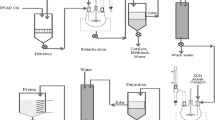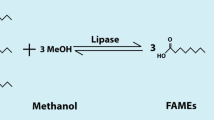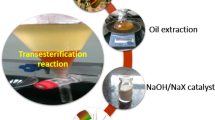Abstract
Previous research suggested that ethyl esters derived from recycled restaurant grease might be a potential source of biodiesel. Accordingly, response surface methodology (RSM) was employed to optimize reaction parameters—temperature, time, level of lipase, mole ratio of reactants—in the PS-30 lipase-catalyzed transesterification reaction of grease to ethyl esters using 95% ethanol. The regression equation obtained by a modified central composite design of RSM predicted optimal reaction conditions of 38.4°C, 2.47 h, 13.7 wt% lipase (PS-30), and a mole ratio of grease to ethanol of 1:6.6. Under these conditions the predicted optimal percentage ethyl ester yield was 85.4%. Subsequent experiments using the predicted parameter combinations indicated a trend where experimental percentage yields of ethyl ester were consistently lower than predicted values. In an effort to improve the experimental yield of esters, a second portion of PS-30 lipase was added without success; however, the addition of 5% SP435 one hour after the start of the initial reaction increased the yield of esters to >96%. Neither lipase PS-30 nor lipase SP435 alone, however, gave the RSM-predicted yield of ethyl esters.
Similar content being viewed by others
References
Dunn, R.O., and M.O. Bagby, Low-Temperature Properties of Triglyceride-Based Diesel Fuels: Transesterified Methyl Ester and Petroleum Middle Distillate/Ester Blends, J. Am. Oil Chem. Soc. 72:895–904 (1995).
Mazed, M.A., J.D. Summers, and D.G. Batchelder, Peanut, Soybean, and Cottonseed Oil as Diesel Fuels, Trans. ASAE 28:1375–1377 (1985).
Grabowski, M.S., and R.L. McCormick, Combustion of Fat and Vegetable Oil Derived Fuels in Diesel Engines, Prog. Energy Combust. Sci. 24:125–164 (1998).
Ali, Y., M.A. Hanna, and L.I. Leviticus, Emissions and Power Characteristics of Diesel Engines on Methyl Soyate and Diesel Fuel Blends, Bioresourc. Technol. 52:185–195 (1995).
Masjuki, H., A.M. Zaki, and S.M. Sapuan, A Rapid Test to Measure Performance, Emissions, and Wear of a Diesel Engine Fueled with Palm Oil Diesel, J. Am. Oil Chem. Soc. 70:1021–1025 (1993).
Sii, H.S., H. Masjuki, and A.M. Zaki, Dynamometer Evaluation and Engine Wear Characteristics of Palmoil Diesel Emulsions, Ibid.:905–909 (1995).
Nelson, L.A., T.A. Foglia, and W.N. Marmer, Lipase-Catalyzed Production of Biodiesel, Ibid.:1191–1195 (1996).
Wu, W.H., T.A. Foglia, W.N. Marmer, R.O. Dunn, C.E. Goering, and T.J. Briggs, Low-Temperature Property and Engine Performance Evaluation of Ethyl and Isopropyl Ester of Tallow and Grease, Ibid.:1173–1178 (1998).
Chemical Marketing Reporter, October, 1998.
Box, G.E.P., W.G. Hunter, and J.S. Hunter, Statistics for Experimenters, John Wiley & Sons, New York, 1980, pp. 510–539.
Foglia, T.A. and K.C. Jones, Quantitation of Neutral Lipid Mixtures Using High Performance Liquid Chromatography with Light Scattering Detection, J. Liq. Chromatogr. 20:1829–1838 (1997).
Vicente, G., A. Coteron, M. Martinez, and J. Aracil, Application of the Factorial Design of Experiments and Response Surface Methodology to Optimize Biodiesel Production, Ind. Crops Prod. 8:29–35 (1998).
Haas, M.J., D.J. Cichowicz, J. Phillips, and R. Moreau, The Hydrolysis of Phosphatidylcholine by an Immobilized Lipase: Optimization of Hydrolysis in Organic Solvents, J. Am. Oil Chem. Soc. 70:111–117 (1993).
Haas, M.J., and K.M. Scott, Diesel Fuel as a Solvent for the Lipase-Catalyzed Alcohol of Triglycerides and Phosphatidylcholine, Ibid.:1497–1504 (1996).
Huang, K.H., and C.C. Akoh, Optimization and Scale-up of Enzymatic Synthesis of Structured Lipids Using RSM, J. Food Sci. 61:137–141 (1996).
Halling, P.J., Thermodynamics Predictions for Biocatalysis in Non-Conventional Media: Theory, Tests and Recommendations for Experimental Design and Analysis, Enz. Microb. Technol. 16:178–206 (1994).
Carrea, G., G. Ottolina, and S. Riva, Role of Solvents in the Control of Enzyme Selectivity in Organic Media, Trends Biotechnol. 13:63–70 (1995).
Bell, G., P.J. Halling, B.D. Moor, J. Partridge, and D.G. Rees, Biocatalyst Behaviour in Low-Water Systems, Ibid.:468–473 (1995).
Author information
Authors and Affiliations
Corresponding author
About this article
Cite this article
Wu, W.H., Foglia, T.A., Marmer, W.N. et al. Optimizing production of ethyl esters of grease using 95% ethanol by response surface methodology. J Amer Oil Chem Soc 76, 517–521 (1999). https://doi.org/10.1007/s11746-999-0034-2
Received:
Accepted:
Issue Date:
DOI: https://doi.org/10.1007/s11746-999-0034-2




